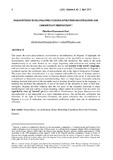Parasynthesis in Degema: Simultaneous affixation or suffixation and concomitant prefixation

View/
Date
2015-04Author
Kari, Ethelbert E.
Publisher
Linguistics Association of SADC UniversitiesRights holder
LASU journal jointly with Ehtelbert E. KariType
Published ArticleMetadata
Show full item recordAbstract
This paper discusses parasynthesis, also known as circumfixation, in Degema. It highlights the fact that circumfixes are controversial not only because of the possibility to analyze them as discontinuous units consisting of prefix-like and suffix-like formatives that apply to the stem simultaneously or as units formed in two stages beginning with suffixation and ending with prefixation but also because they are considered rare or non-existent in the world’s languages, and are ruled out as impossible in some theories even in principle. Circumfixation in Degema is examined against the traditional view of parasynthesis and in the light of Generative Grammar. The paper notes that circumfixation is a very common and productive way of forming agentive and gerundive nominals and state nouns in Degema, despite claims of its rarity. It also notes that a traditional or theoretical analysis notwithstanding, there is a high degree of morpho-semantic bonding between both parts of the circumfix used in forming deverbal nouns in the language – a bonding that prohibits the optionality of any of the parts of the circumfix in spite of their non-contiguity. Degema provides evidence that the two parts of the circumfix constitute a single morphological unit and express a single meaning, which cannot be realized if the two parts are regarded as cases of “normal” prefixes and suffixes. Furthermore, the paper demonstrates that circumfixation is not impossible as a word formation process, like prefixation, suffixation and infixation. In the light of Generative Grammar, the paper concludes that circumfixation in Degema is a case of suffixation and concomitant prefixation rather than one of simultaneous affixation.
